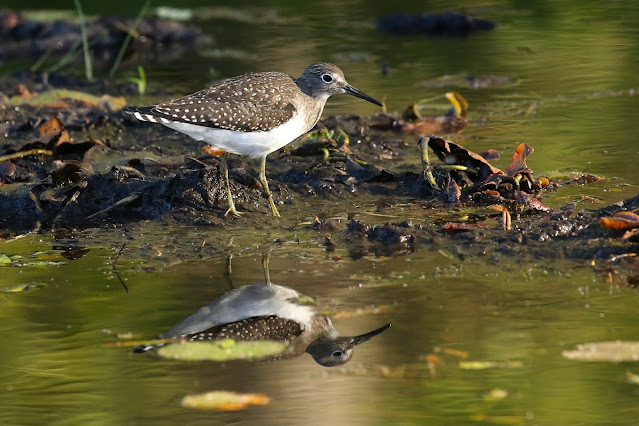After living here on our little lake in the Manistee National Forest for almost five years I've got a pretty good sense of what birds we see when. I've been keeping annual and all-time "yard lists"--I say this with quotes because it's really more like a patch that includes our property, the lake, and the two track that circles it--as well as a short list of when certain species show up for the first time each season.
One thing I've noticed is that we do not typically get any sandpipers here in the spring. I suspect this is due to higher water levels resulting in a lack of appropriate habitat. Our lake is a kettle, a tiny and shallow thing carved out by glaciers, and has no in or out flow of water. It gets what it gets from rain and snow. This can vary wildly year to year--in the 18 months from the fall of 2018 until the spring of 2020 we had an abundance of precipitation, resulting in the flooding of our boardwalk for much of 2020. The the drought started in June 2020, and by this spring the fen was nothing but black muck.
Because of the wildly swinging weather patterns it's hard to know what normal is after only five summers, but what makes sense is that typically the fen is flooded in spring with snowmelt, dries out slowly over the summer, and by August is without standing water--a vernal pond, essentially. The lake level drops too, and by August there are exposed mud flats here and there that draw sandpipers on their southbound migration. So far the only species I've seen are spotted and solitary, and that may be all we get.
This year I went down to the dock to find a pair of solitary sandpipers--the most common species we see here--on some floating detritus about 40 feet from the end of our dock. I went back to the house and got my camera and snuck back down to try for some photos. That evening the girls went fishing and said the birds were literally right next to the boat--so much for the need to sneak. So I went out in the peddle boat the next evening and pretty much parked and let the birds come to me. There was one adult and two juveniles, the adult distinguished by the bold white spots on the wings and scapulars. At a distance these birds seem quite drab but up close their markings are bold, and I love that white eye ring. They went about their business, picking at insects and crustaceans in the muck, not paying me much mind at all.
 |
| Adult |
 |
| Juvenile |











Wonderful photos! Thank you for the education too!
ReplyDeleteThanks!
Delete